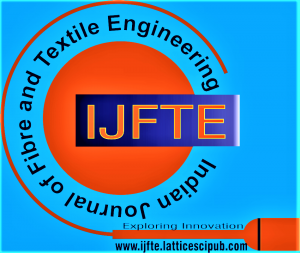Optimization of Fabric Parameters on the Effectual Properties of Nonwoven Industrial Wipes Blend using Response Surface Methodology
Jonathan Tersur Orasugha,b,c,d,e, Kausik Bal*b, Dipankar Chattopadhyaya, Swapan Kumar Ghosh*b, Suprakash Sinha Rayc,d
*Corresponding author(s)
aDepartment of Polymer Science and Technology, University of Calcutta, 92 A.P.C. Road, Kolkata -700 009, India.
bDepartment of Jute and Fibre Technology, Institute of Jute Technology, University of Calcutta, 35 Ballygunge Circular Road, Kolkata -700 019, West Bengal, India.
cDepartment of Chemical Sciences, University of Johannesburg, Doorfontein, Johannesburg 2028, South Africa.
dDST-CSIR National Centre for Nanostructured Materials, Council for Scientific and Industrial Research, Pretoria 0001, South Africa.
eDepartment of Chemistry, University of Abuja, P.M.B 117 Main Campus, Abuja Airport Road FCT – Abuja, Nigeria.
Manuscript received on 02 December 2021 | Revised Manuscript received on 22 July 2022 | Manuscript Accepted on 15 November 2022 | Manuscript published on 30 November 2022 | PP: 1-9 | Volume-2 Issue-2, November 2022 | Retrieval Number: 100.1/ijfte.C2401051322 | DOI: 10.54105/ijfte.C2401.111422
Open Access | Ethics and Policies | Cite | Mendeley | Indexing and Abstracting
© The Authors. Published by Lattice Science Publication (LSP). This is an open-access article under the CC-BY-NC-ND license (http://creativecommons.org/licenses/by-nc-nd/4.0/)
Abstract: Development in technical in textiles especially nonwoven fabrics/materials offers a brightly limitless prospect for the textile industry to lance into an extensive series of applications ranging from earth to space and beyond. Nonwoven industrial wipes fabric properties are the result of production technology and the combination of fabric constructional parameters. This work looks into the effect of fabric parameters on the desired properties of nonwoven industrial wipes fabricated by needle punching technique with the utilization of viscose and polyester fibres and their blends using RSM. The basic and essential characterization techniques to obtain information related to physiochemical properties of the nonwoven fabrics, using analytical investigation techniques have been evaluated. The results obtained established that the fabric parameters have a great influence on the nonwoven fabric structure and ultimately its properties. The result revealed that higher content of PET fibres led to a reduction in the vertical wicking rate, but better rising height can be achieved at samples made from 100 % of viscose fibres. Also, the influence of pore size and porosity largely influenced the fabric characteristics. The fibre volume fraction on the strength of nonwovens has been studied. The fabricated wipes present themselves as potential candidates for highly absorbent industrial wipes.
Keywords: Textiles, Nonwovens, Bonding, Web formation, Consumer wipes, Industrial wipes, Market, Technology.
Scope of the Article: Fabrics
